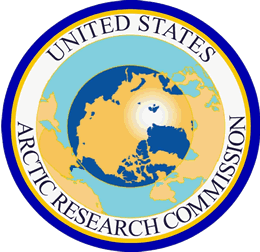
U.S. Arctic Research Commission
Encyclopedia

The United States Arctic Research Commission is a United States federal agency. It was established by the Arctic Research and Policy Act of 1984 (as amended, Public Law 101-609).
Duties
The Commission’s principal duties are:- to establish the national policy, priorities, and goals necessary to construct a federal program plan for basic and applied scientific research with respect to the Arctic, including natural resources and materials, physical, biological and health sciences, and social and behavioral sciences;
- to promote Arctic research, to recommend Arctic research policy, and to communicate our research and policy recommendations to the PresidentPresident of the United StatesThe President of the United States of America is the head of state and head of government of the United States. The president leads the executive branch of the federal government and is the commander-in-chief of the United States Armed Forces....
and the CongressUnited States CongressThe United States Congress is the bicameral legislature of the federal government of the United States, consisting of the Senate and the House of Representatives. The Congress meets in the United States Capitol in Washington, D.C....
; - to work with the National Science FoundationNational Science FoundationThe National Science Foundation is a United States government agency that supports fundamental research and education in all the non-medical fields of science and engineering. Its medical counterpart is the National Institutes of Health...
as the lead agency responsible for implementing the Arctic research policy and to support cooperation and collaboration throughout the Federal Government; - to give guidance to the Interagency Arctic Research Policy Committee (IARPC) to develop national Arctic research projects and a five-year plan to implement those projects; and
- to interact with Arctic residents, international Arctic research programs and organizations and local institutions including regional governments in order to obtain the broadest possible view of Arctic research needs.
The Arctic Research and Policy Act was amended in 1990 to increase the number of Commissioners appointed by the President of the United States
President of the United States
The President of the United States of America is the head of state and head of government of the United States. The president leads the executive branch of the federal government and is the commander-in-chief of the United States Armed Forces....
from five to seven voting members. Four members are from academic or research institutions; two members from private industry undertaking commercial activities in the Arctic; and one member from among the indigenous residents of the US Arctic. The Director of the National Science Foundation serves as an ex officio member.
Staff
The Commission staff consists of an Executive Director in Arlington County, VirginiaArlington County, Virginia
Arlington County is a county in the Commonwealth of Virginia. The land that became Arlington was originally donated by Virginia to the United States government to form part of the new federal capital district. On February 27, 1801, the United States Congress organized the area as a subdivision of...
, a Senior Staff Officer in Anchorage, Alaska
Anchorage, Alaska
Anchorage is a unified home rule municipality in the southcentral part of the U.S. state of Alaska. It is the northernmost major city in the United States...
, and an Administrative Officer in the Arlington office. The principal office of the Commission is in Arlington and the Alaska office of the Commission is located in Anchorage. Advisors are appointed by the Commission on an "as needed" basis to provide information and advice on particular research needs and issues of concern to the Commission, review draft documents of the Commission and convey information of importance on the various scientific and engineering disciplines they represent.
External links
- Arctic Research Commission Meeting Notices and Rule Changes from The Federal Register RSS Feed

